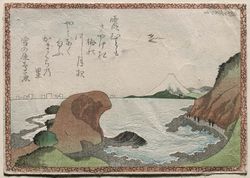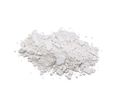Difference between revisions of "Category:Calcium carbonate: Ukiyo-e colorant"
| (11 intermediate revisions by the same user not shown) | |||
| Line 2: | Line 2: | ||
[[File:SC155045.jpg|right|250px|link=https://collections.mfa.org/objects/207552/kamakura-village-from-an-untitled-series-of-westernstyle-l?ctx=1be86594-d25a-458d-827f-8e5dc3048977&idx=0|Kamakura Village by Katsushika Hokusai]] | [[File:SC155045.jpg|right|250px|link=https://collections.mfa.org/objects/207552/kamakura-village-from-an-untitled-series-of-westernstyle-l?ctx=1be86594-d25a-458d-827f-8e5dc3048977&idx=0|Kamakura Village by Katsushika Hokusai]] | ||
| − | <font size="3">'''[[Calcium carbonate]]'''</font> 胡粉(''gofun''): | + | <font size="3">'''[[Calcium carbonate]]'''</font> 胡粉(''gofun''): A white powder that can occur in three crystalline forms: [[calcite]] (hexagonal-rhombohedral), [[aragonite]] (orthorhombic) and vaterite. Calcium carbonate occurs naturally in many forms such as [[chalk]], [[limestone]], [[marble]] and [[seashell|sea shells]]. In Japan, the source is sea shells. <!--Before the 15c., the term gofun has been used to also indicate lead white but today it is exclusively used for calcium carbonate.--> |
| + | Calcium carbonate can be difficult to confirm as a printed color since the water used papermaking can be have high concentrations of calcium; also it was sometimes used as an additive to the pulp during papermaking. | ||
| + | |||
| + | Calcium carbonate has been found mixed with [[:Category:Carbon black:Ukiyo-e colorant|carbon black]] to create a wide range of gray tones that can appear as a pale blue color. Extensive use of calcium carbonate is found on Harunobu’s ''mizu-e'' or water prints of the 1760’s which are images printed with no or faintly printed outlines. Sometimes a calcium carbonate paint was spattered across the surface of a completed print in order to approximate the appearance of snow or sea spray. | ||
'''For more information see:''' [[Calcium carbonate]] | '''For more information see:''' [[Calcium carbonate]] | ||
| Line 43: | Line 46: | ||
== Analysis == | == Analysis == | ||
| − | + | X-ray fluorescence analysis (XRF) is used to detect calcium, which in a white area, is an indication for the presence of calcium carbonate (CaCO<sub>3</sub>). | |
| − | |||
<gallery mode="packed" heights="200px" style="text-align:left"> | <gallery mode="packed" heights="200px" style="text-align:left"> | ||
Madder EEM ref.jpg|<center>EEM plot for Madder</center> | Madder EEM ref.jpg|<center>EEM plot for Madder</center> | ||
| − | |||
| − | |||
| − | |||
</gallery> | </gallery> | ||
| − | |||
==Other Images of Calcium carbonate == | ==Other Images of Calcium carbonate == | ||
<gallery> | <gallery> | ||
Gofun.jpg|Gofun, <small>by Musashino Art University</small> | Gofun.jpg|Gofun, <small>by Musashino Art University</small> | ||
| − | Oyster | + | Oyster shells.jpg|Weathered oyster shells, <small>by Central Japan Railway Company</small> |
</gallery> | </gallery> | ||
Revision as of 00:50, 27 July 2020
Calcium carbonate 胡粉(gofun): A white powder that can occur in three crystalline forms: Calcite (hexagonal-rhombohedral), Aragonite (orthorhombic) and vaterite. Calcium carbonate occurs naturally in many forms such as Chalk, Limestone, Marble and sea shells. In Japan, the source is sea shells.
Calcium carbonate can be difficult to confirm as a printed color since the water used papermaking can be have high concentrations of calcium; also it was sometimes used as an additive to the pulp during papermaking.
Calcium carbonate has been found mixed with carbon black to create a wide range of gray tones that can appear as a pale blue color. Extensive use of calcium carbonate is found on Harunobu’s mizu-e or water prints of the 1760’s which are images printed with no or faintly printed outlines. Sometimes a calcium carbonate paint was spattered across the surface of a completed print in order to approximate the appearance of snow or sea spray.
For more information see: Calcium carbonate
Examples of Calcium carbonate in Ukiyo-e Prints

|

|

|

|

|
Analysis
X-ray fluorescence analysis (XRF) is used to detect calcium, which in a white area, is an indication for the presence of calcium carbonate (CaCO3).
Other Images of Calcium carbonate
Pages in category "Calcium carbonate: Ukiyo-e colorant"
The following 3 pages are in this category, out of 3 total.




